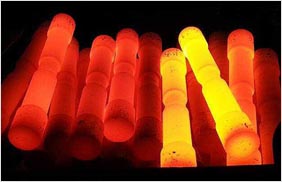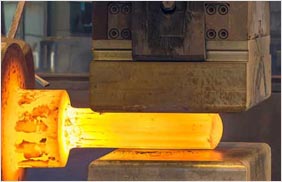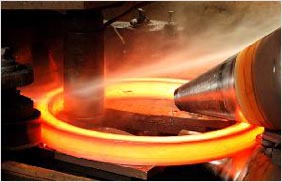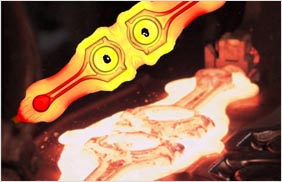Forging is manufacturing process where metal is pressed, pounded or squeezed under great pres-sure into high strength parts known as forgings. The process is normally (but not always) per-formed hot by preheating the metal to a desired temperature before it is worked. It is important to note that the forging process is entirely different from the casting (or foundry) process, as metal used to make forged parts is never melted and poured (as in the casting process). Forging has been done by smiths for millennia; the traditional products were kitchenware, hardware, hand tools, edged weapons, cymbals, and jewelry. Since the Industrial Revolution, forged parts are widely used in mechanisms and machines wherever a component requires high strength; such forgings usually require further processing (such as machining) to achieve a finished part.
Sub-categories of Forging includes:
Heading Heading is a metalworking process which incorporates the forging, extruding and upsetting pro-cess. It is often performed in the cold state, resulting in cold working. This process typically pro-duces a near net shape workpiece, which means the final product is almost finished although it can sometimes create the final product less Plating or Heat Treating. An important consideration in heading is the tendency for the wire to buckle if its unsupported length to diameter ratio is too high. This ratio usually is limited to less than 3:1 but with appropriate dies, it can be higher. There are a variety of cold heading machines but typically for Fastener manufacturing you will see One Die Two Blow up to Five Die Six Blow and beyond. Multi-Die headers allow for more complex parts to be formed as part of one process due to the above limitations of diameter ratio reduc-tions. Some advantages of Cold Heading a part over using a CNC Lathe or Swiss Screw Machine include reduced part cost both through production speed (60-400 parts per minute) and the min-imal scrap generated from a cold headed part. Also, because the part is formed rather than cut, the grain flow stays intact and creates a much stronger part for its size.
Heading is a metalworking process which incorporates the forging, extruding and upsetting pro-cess. It is often performed in the cold state, resulting in cold working. This process typically pro-duces a near net shape workpiece, which means the final product is almost finished although it can sometimes create the final product less Plating or Heat Treating. An important consideration in heading is the tendency for the wire to buckle if its unsupported length to diameter ratio is too high. This ratio usually is limited to less than 3:1 but with appropriate dies, it can be higher. There are a variety of cold heading machines but typically for Fastener manufacturing you will see One Die Two Blow up to Five Die Six Blow and beyond. Multi-Die headers allow for more complex parts to be formed as part of one process due to the above limitations of diameter ratio reduc-tions. Some advantages of Cold Heading a part over using a CNC Lathe or Swiss Screw Machine include reduced part cost both through production speed (60-400 parts per minute) and the min-imal scrap generated from a cold headed part. Also, because the part is formed rather than cut, the grain flow stays intact and creates a much stronger part for its size.
Impression Die Forging  In the simplest example of impression die forging, two dies are brought together and the workpiece undergoes plastic deformation until its enlarged sides touch the side walls of the die. Then, a small amount of material begins to flow outside the die impression forming flash that is gradually thinned. The flash cools rapidly and presents increased resistance to deformation and helps build up pressure inside the bulk of the workpiece that aids material flow into unfilled impressions. Fundamentally, impression die forgings produced on horizontal forging machines (up setters) are similar to those produced by hammers or presses. Each is the result of forcing metal into cavities in dies which separate at parting lines. The impression in the ram-operated "heading tool" is the equivalent of a hammer or press top die. The "grip dies" contain the impressions corresponding to the hammer or press bottom die. Grip dies consist of a stationary die and a moving die which, when closed, act to grip the stock and hold it in position for forging. After each work stroke of the machine, these dies permit the transfer of stock from one cavity to another in the multiple-impression dies.
In the simplest example of impression die forging, two dies are brought together and the workpiece undergoes plastic deformation until its enlarged sides touch the side walls of the die. Then, a small amount of material begins to flow outside the die impression forming flash that is gradually thinned. The flash cools rapidly and presents increased resistance to deformation and helps build up pressure inside the bulk of the workpiece that aids material flow into unfilled impressions. Fundamentally, impression die forgings produced on horizontal forging machines (up setters) are similar to those produced by hammers or presses. Each is the result of forcing metal into cavities in dies which separate at parting lines. The impression in the ram-operated "heading tool" is the equivalent of a hammer or press top die. The "grip dies" contain the impressions corresponding to the hammer or press bottom die. Grip dies consist of a stationary die and a moving die which, when closed, act to grip the stock and hold it in position for forging. After each work stroke of the machine, these dies permit the transfer of stock from one cavity to another in the multiple-impression dies.
Open Die Forging  Open die forging is the process of deforming a piece of metal between multiple dies that do not completely enclose the material. The metal is altered as the dies "hammer" or "stamp" the material through a series of movements until the desired shape is achieved. Products formed through open forging often need secondary machining and refining to achieve the tolerances required for the finished specifications. Open die forging is widely used for the products in small quantity that are simple, rather than complex, such as discs, rings, sleeves, cylinders and shafts. Custom shapes can also be produced with open die forging. The strength of the grain structure will be increased during the deformation process due to the repeated working of the steel billet. Another benefit of open die forging is that the fatigue resistance and strength of products will be improved. Besides, voids could be effectively reduced after open die forging.
Open die forging is the process of deforming a piece of metal between multiple dies that do not completely enclose the material. The metal is altered as the dies "hammer" or "stamp" the material through a series of movements until the desired shape is achieved. Products formed through open forging often need secondary machining and refining to achieve the tolerances required for the finished specifications. Open die forging is widely used for the products in small quantity that are simple, rather than complex, such as discs, rings, sleeves, cylinders and shafts. Custom shapes can also be produced with open die forging. The strength of the grain structure will be increased during the deformation process due to the repeated working of the steel billet. Another benefit of open die forging is that the fatigue resistance and strength of products will be improved. Besides, voids could be effectively reduced after open die forging.
Roll Forging  Roll forging or roll forming is a forging technique that utilizes opposing rolls to shape a metal part. Even though roll forging uses rolls in order to accomplish the deformation of the material, it is classified as a metal forging process and not a rolling process. More similarly to metal forging than metal rolling, it is a discrete process and not a continuous one. Roll forging is usually per-formed hot. The precisely shaped geometry of grooves on the roll, forge the part to the required dimensions. The forging geometry of the rolls used to forge metal parts is only present over a portion of the roll's circumference. Only part of a full revolution of a roll is needed to forge the work piece. Typically in manufacturing industry, the forging geometry on the rolls may occupy from one quarter to three quarters of the roll's circumference. The non-grooved portion of the roll's revolution is useful for feeding the stock during the process. Also it can be determined that the length of a work piece that can be metal forged by this manufacturing process, is limited by the size of the rolls and the portion of the rolls over which the forming of the metal occurs. First the work piece is fed into the rolls at the correct place in the roll's revolution. The rolls turn, act-ing to pull the work into the gap. As the work piece is fed through the grooved portion of the roll's revolution, the compressive forces form the material into the desired shape. Roll forging manufacture is often used in the automotive industry to manufacture parts. Shafts of various ge-ometries, knives, hand tools and leaf springs, are some products commonly manufactured by this process. Parts created by roll forging possess superior mechanical properties than those produced from many other processes.
Roll forging or roll forming is a forging technique that utilizes opposing rolls to shape a metal part. Even though roll forging uses rolls in order to accomplish the deformation of the material, it is classified as a metal forging process and not a rolling process. More similarly to metal forging than metal rolling, it is a discrete process and not a continuous one. Roll forging is usually per-formed hot. The precisely shaped geometry of grooves on the roll, forge the part to the required dimensions. The forging geometry of the rolls used to forge metal parts is only present over a portion of the roll's circumference. Only part of a full revolution of a roll is needed to forge the work piece. Typically in manufacturing industry, the forging geometry on the rolls may occupy from one quarter to three quarters of the roll's circumference. The non-grooved portion of the roll's revolution is useful for feeding the stock during the process. Also it can be determined that the length of a work piece that can be metal forged by this manufacturing process, is limited by the size of the rolls and the portion of the rolls over which the forming of the metal occurs. First the work piece is fed into the rolls at the correct place in the roll's revolution. The rolls turn, act-ing to pull the work into the gap. As the work piece is fed through the grooved portion of the roll's revolution, the compressive forces form the material into the desired shape. Roll forging manufacture is often used in the automotive industry to manufacture parts. Shafts of various ge-ometries, knives, hand tools and leaf springs, are some products commonly manufactured by this process. Parts created by roll forging possess superior mechanical properties than those produced from many other processes.
Near-Net-Shape Forging  Near Net Shape Forging represents some relatively recent developments of the conventional im-pression die forging process. Net and near net shape forgings are distinguished by geometric fea-tures that are thinner and more detailed, varying parting line locations, and virtual elimination of draft, closer dimensional tolerances and with many as-forged surfaces. The resulting product benefits are much fewer machining operations, reduced weight and lower costs for raw materials and energy. In many cases, the only machining operations required are drilling of attachment holes. Net and near net shape forgings in the as-forged and heat treated condition usually reflect a higher production cost than do their conventionally forged counterparts. They are often but not necessarily flashless. The cost advantage shifts to net shape forging as post-forging machining operations are eliminated. A cost study for an aircraft aluminum forging made by four processes identifies the cost drivers and illustrates the trade-offs for this application. The four processes are hand forging, blocker type (forging to approximate shape and machining), conventional forging and net shape forging.
Near Net Shape Forging represents some relatively recent developments of the conventional im-pression die forging process. Net and near net shape forgings are distinguished by geometric fea-tures that are thinner and more detailed, varying parting line locations, and virtual elimination of draft, closer dimensional tolerances and with many as-forged surfaces. The resulting product benefits are much fewer machining operations, reduced weight and lower costs for raw materials and energy. In many cases, the only machining operations required are drilling of attachment holes. Net and near net shape forgings in the as-forged and heat treated condition usually reflect a higher production cost than do their conventionally forged counterparts. They are often but not necessarily flashless. The cost advantage shifts to net shape forging as post-forging machining operations are eliminated. A cost study for an aircraft aluminum forging made by four processes identifies the cost drivers and illustrates the trade-offs for this application. The four processes are hand forging, blocker type (forging to approximate shape and machining), conventional forging and net shape forging.